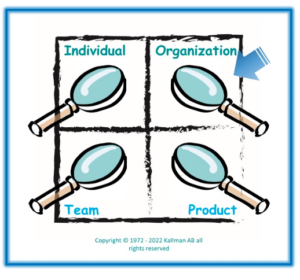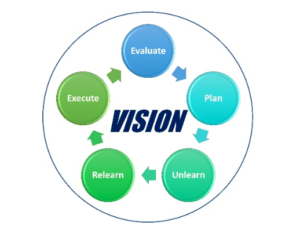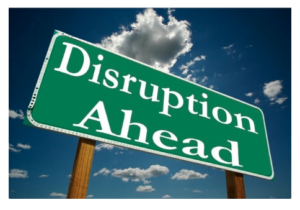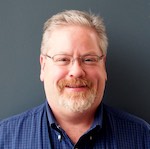 Many organizations get so caught up in what they currently do and how they do it, that they cannot find ways to effectively improve how they operate and experience the growth that stems from that kind of change. Plotting a path to organizational growth, especially based on the projects it chooses to execute, can be a challenge. The fundamental elements are not overly complicated, but the work to make the change is hard.
Many organizations get so caught up in what they currently do and how they do it, that they cannot find ways to effectively improve how they operate and experience the growth that stems from that kind of change. Plotting a path to organizational growth, especially based on the projects it chooses to execute, can be a challenge. The fundamental elements are not overly complicated, but the work to make the change is hard.
Stripping back the veneer of “pretend change” and finding how execution Value comes from properly communicated Vision and choices rooted in those fundamental elements often takes fresh eyes and a willingness to do things in a very different way. It can be a bit unnerving, but the alternative is stagnation.
Through this series of articles, we’ll highlight and discuss some of the fundamental elements that are necessary to effect real growth and improvement that is sustainable, and weed out the things that only add noise and distraction.
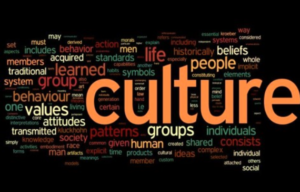 Culture, Sustainable Vision, and the Four Lenses
Culture, Sustainable Vision, and the Four Lenses
In the previous article, we focused on Vision and the key steps of Flow (from Andrew Kallman). In this final installment, we’ll add in some thoughts about Culture, how an organization can approach sustainability rooted in Vision, and the Four Lenses available when examining any organization or process. But of all the topics we’ll cover in this article, Culture is the most critical. In fact, in much of what you read here on LinkedIn and elsewhere about business, hiring, the “Great Resignation”, and a host of other topics you will find the thread of Culture running throughout them. Often it is the most prominent theme. It’s just that important to understand how Culture either breeds change or buries it.
“Culture eats Strategy for breakfast” is most often attributed to the late management guru Peter Drucker. In truth, that attribution is likely only partially true, but certainly the spirit of the saying matches the mantra Drucker espoused and practiced. The co-founder of Flow (the meta framework we follow) took that statement several steps further. His view (and ours) illustrates how powerful Culture is and how it connects to every element in an organization that you need to map out and achieve true change.
This image, with the arc running from Vision to Goals & Objectives is structured in a way that moves from the higher level (and broader) to the lower level (and more specific). It’s a progressive chain that builds on the previous point as you progress to the specific Value any initiative or project is intended to produce. As we’ve stated before, it all starts with Vision as the initial focal point. And, when the end goal is to effect true change, you most certainly want that clear Vision at the start plus a Culture that not only embraces change, but actively seeks out the RIGHT changes that build toward a better future.
On the other end of the spectrum, a Culture that resists change will always hold an organization back. We discussed some of this in the first article when we talked about Barriers to Change. A resistive Culture is anti-change and, whether actively or passively, supports a stagnant state that undermines Trust and remains complacent (or even hostile) to growth. Those organizations end up mired in the lowest levels of maturity and rarely find a way out (unless there are significant outside actors that force the issue).
Change breeds change and Culture is a primary fuel to make that happen. As Andrew Kallman said (building on Drucker’s assertion), Culture eats EVERYTHING for breakfast, lunch and dinner. Creating an organizational Culture that encourages change is a critical foundation for the sustainability that allows you to move up the maturity model and find a path to lasting improvement.
The Flow framework will take an iterative approach to every situation by examining the organization (or one of the other subordinate elements) through a specific lens with tools tailored to that particular level. In total, there are four lenses covering (from the highest level to the lowest) Organization, Product, Team, and Individual. The majority of what we’ve offered in this series of articles has been focused on the Organizational lens (the highest level) since we’re focusing on growth and improvement there. But the same approach can be taken for the other levels, though without true organizational change, any attempt will be limited at best and likely not sustainable to any degree.
Tools such as the 4-D Model (introduced in the previous installment) follow this pattern well. They are highly valuable all the way down to the Individual lens perspective, but without the most senior leadership embracing all aspects of the intended change, very little will last or have a chance to “bubble upward” to impact an entire Team, a Product, or the Organization. This ties back directly to Culture and the overarching perspective, discipline, and willingness to grow and improve. None of it is impossible and little has to be complicated. The challenge is, as we’ve said several times before, it ends up being hard work and some organizations just don’t have the patience or fortitude to get through it. Their Culture prefers the status quo, even if that means forgoing a chance to grow.
Ultimately, none of it matters if the organization won’t commit to sustaining the change it starts. Once again, this goes back to Culture that actively seeks change and the clear, cohesive Vision that leadership casts and reinforces at every turn sitting right smack in the center.
The graphic we chose to illustrate sustainability does just that to reinforce the centrality of Vision in the entire change process. Starting at the top of the diagram, the organization needs to start evaluating where they are, what they are doing, what isn’t going right, and possible options to move beyond the status quo, taking into account the barriers that impact and hold back that change. This takes the discipline and hard work we’ve called out multiple times as you craft a plan that matches your goals and closes the gaps you uncovered as you did your introspective evaluation.
Earlier in the series, we introduced the concept of “Un-Learning” and noted that it’s something you can’t short-circuit if you are serious about true change. This goes beyond learning something “new” and serves as the foundation to “Re-Learn” the right things the right way and move your organization toward the goals that ultimately matter and accelerate your migration up the maturity model steps. Again, it’s not complicated work … it’s just hard and many organizations will make some initial attempts and then turn back to the status quo or find something “easier”.
Keep in mind it has to be cyclical. You never actually “make it” to the end, but rather take everything you do back through the same cycle of evaluation so you can continuously tie back to the Vision and leverage tools like the 4-D Model to course correct as you progress.
If you do it right, there will be Disruption. But it will be the right level and kind of disruption that shapes your future growth and highlights what you need to do (and not do) in order to continue growing. It’s the kind of disruption that likely feels uncomfortable when you are first going through it, but somehow feels “right” when you navigate through it and see the results you’ve achieved and the maturity you’ve gained.
Seeking Disruption teaches you far more than you would have learned had you chosen to plod along a relatively stagnant, “safer” path. That option is highly resistant to true change and, very often, littered with the kind of “fake changes” that may look good at first, but wear very thin very quickly. You want the kind of change that is sustainable and breeds more change. You want an organizational culture that embraces trust and innovation. You want a level of maturity that finds Flow easily and seamlessly integrates it into everything your organization attempts.
Bio
Mark Moore, M2PCC’s Executive Consultant, is an experienced leader and communicator, with a long track record of successful program and project management, training development and delivery, and transformational change. He brings over three decades of experience spanning multiple industries and disciplines. His focus on delivery of Value aligned with Vision lies at the heart of FLOW and organizational transformation.
Executive Consultant
mark@m2projectconsultingcorp.com
919.724.3679

